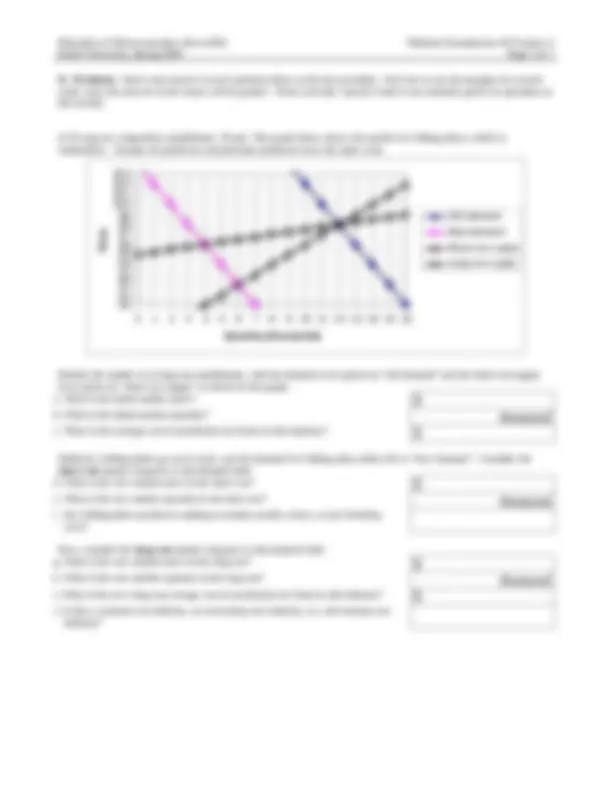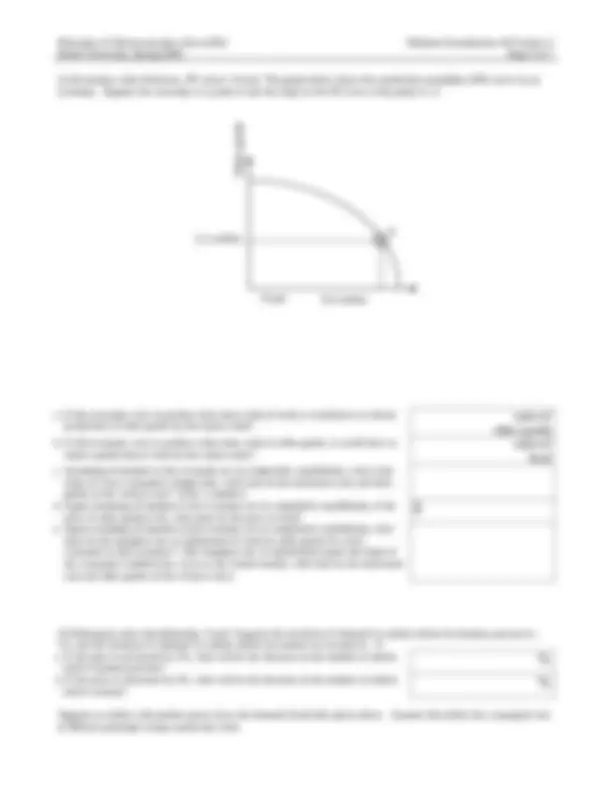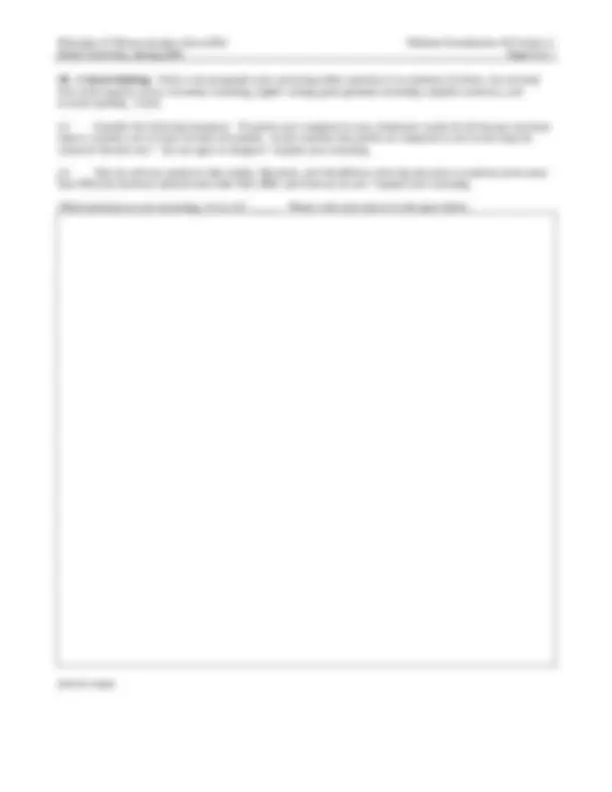






Study with the several resources on Docsity

Earn points by helping other students or get them with a premium plan


Prepare for your exams
Study with the several resources on Docsity

Earn points to download
Earn points by helping other students or get them with a premium plan
Community
Ask the community for help and clear up your study doubts
Discover the best universities in your country according to Docsity users
Free resources
Download our free guides on studying techniques, anxiety management strategies, and thesis advice from Docsity tutors
Material Type: Exam; Professor: Boal; Class: PRINCIPLES OF MICROECONOMICS; Subject: Economics; University: Drake University; Term: Spring 2004;
Typology: Exams
1 / 8

This page cannot be seen from the preview
Don't miss anything!





Principles of Microeconomics (Econ 002) Signature: Drake University, Spring 2004 William M. Boal Printed name:
INSTRUCTIONS: This exam is closed-book, closed-notes. Simple calculators are permitted, but graphing calculators or calculators with alphabetical keyboards are NOT permitted. Numerical answers, if rounded, must be correct to at least 3 significant digits. Point values for each question are noted in brackets. Maximum total points are 100. I. Multiple choice: Circle the one best answer to each question. [1 pt each: 15 pts total] (1) A perfectly competitive firm expects that if it increases its output, this will cause the price to a. increase. b. stay the same. c. decrease. d. cannot be determined from information given. (2) A firm that takes price as given believes its marginal revenue from selling one more unit will be a. equal to the price of that unit. b. greater than the price of that unit. c. less than the price of that unit. d. equal to zero. (3) If price is currently equal to long-run average cost in a particular industry, in the long run, we should expect a. neither entry nor exit of firms in the industry. b. the demand curve to shift right. c. entry of new firms into the industry. d. some existing firms to leave the industry. (4) Exit of firms from an industry a. causes the short-run supply curve to become downward-sloping. b. has no effect on the short-run supply curve. c. shifts the short-run supply curve left. d. shifts the short-run supply curve right. (5) In a perfectly competitive industry, economic profit equals zero in the long run because a. entry and exit of firms eliminate economic profit or loss. b. consumers know the average cost of the product and refuse to pay more. c. producers keep prices low to avoid accusations of "gouging." d. each firm sets output according to the rule "price=average cost" to maximize profit. (6) Suppose a pie is cut into four pieces and is to be allocated between three people. Which allocation is not Pareto-efficient? a. Person #1 gets all four pieces, while Persons B and C get none. b. Person #1 gets one piece, Person #2 gets one piece, Person #3 gets one piece, and the last piece is discarded. c. Person #1 gets one piece, Person #2 gets one piece, and Person #3 gets two pieces. d. All of the above are Pareto-efficient. (7) If every consumer in the economy faces the same prices, then every consumer a. will choose combinations of goods where their marginal rates of substitution are exactly identical. b. has exactly the same income. c. will choose exactly the same combinations, or bundles, of goods. d. has exactly the same budget line. (8) Suppose an economy is at point A in the diagram below of a production-possibility curve. Assume the slope of the production-possibility curve is -3 at point A. Meanwhile, the slope of every consumer's indifference curve, with food on the vertical axis and shelter on the horizontal axis, is also -3. This economy could make consumers better off by producing a. more shelter and less food. b. more food and less shelter. c. less shelter and less food. d. Consumers cannot be made better off by changing the mix of outputs.
Drake University, Spring 2004 Page 2 of 7 (9) Suppose the price of a cell phone is $40 and the price of a DVD player is $120. If the economy is perfectly competitive, then these prices indicate that the economy's opportunity cost of a DVD player (that is, the slope of the production-possibility curve with DVD players on the horizontal axis) is a. 40 cell phones. b. 3 cell phones. c. 1 cell phone. d. 1/3 of a cell phone. (10) Suppose a hot-dog vendor with market power is now selling five hot-dogs per hour at a price of $1.50. If she cuts the price to $1.40, she can sell one more hot- dog per hour (that is, a total of six hot-dogs per hour). The vendor's marginal revenue is therefore a. $0.. b. $0.. c. $1.. d. $1.. (11) Suppose an individual firm faces downward- sloping demand, depicted by the solid line in the graph below. Which dotted line in this graph depicts the firm's marginal revenue? a. Line A. b. Line B. c. Line C. d. Line D. (12) Suppose the marginal cost of producing a particular product is $8 and the elasticity of demand for the product is -5. To maximize profit, a monopolist should set a price of a. $40. b. $10. c. $8. d. $5. (13) Suppose a monopolist can charge different prices for the same good in different market segments. To maximize profit, the monopolist will set a. the same price in both market segments, since they have the same marginal cost. b. a lower price in the market segment with the less elastic demand curve. c. a higher price in the market segment with the less elastic demand curve d. Cannot be determined from the information given. (14) A cartel must face the problem that each member firm will want to cheat on the cartel agreement by a. increasing output beyond its quota. b. producing less than its quota of output. c. raising its price higher than the cartel's agreed price. d. none of the above. (15) A firm can enjoy market power (power over price) if a. there is only one firm in the industry. b. the products of different firms in the industry are viewed by consumers as perfect substitutes. c. Either of the above. d. None of the above.
Shelter Food Line A Line B Line C Line D Price Quantity Demand
Drake University, Spring 2004 Page 4 of 7 (2) [Economy-wide efficiency, PP curves: 10 pts] The graph below shows the production possibility (PP) curve for an economy. Suppose the economy is at point A and the slope of the PP curve at that point is -. a. If this economy were to produce sixty more units of food, it would have to reduce production of other goods by how many units?
b. If this economy were to produce sixty more units of other goods, it would have to reduce production of food by how many units?
c. Assuming all markets in the economy are in competitive equilibrium, what is the slope of every consumer's budget line, with food on the horizontal axis and other goods on the vertical axis? (Give a number.) d. Again assuming all markets in the economy are in competitive equilibrium, if the price of other goods is $1, what must be the price of food?
e. Again assuming all markets in the economy are in competitive equilibrium, what must be the marginal rate of substitution of food for other goods for every consumer in this economy? (The marginal rate of substitution equals the slope of the consumer's indifference curve at the chosen bundle, with food on the horizontal axis and other goods on the vertical axis.) (3) [Monopoly price discrimination: 8 pts] Suppose the elasticity of demand for airline tickets by business persons is - 2.5, and the elasticity of demand for airline tickets by tourists on vacation is –. a. If the price is increased by 2%, what will be the decrease in the number of tickets sold to business persons?
b. If the price is increased by 2%, what will be the decrease in the number of tickets sold to tourists?
Suppose an airline with market power faces the demand elasticities given above. Assume this airline has a marginal cost of $60 per passenger along a particular route. 2.1 million Food (^) 8.3 million
Other goods
Drake University, Spring 2004 Page 5 of 7
Drake University, Spring 2004 Page 7 of 7 (5) [Monopolistic competition: 20 pts] The following diagram shows a road with two convenience stores at each end and five consumers, denoted A through E, living between them on the same road. The round-trip travel time between any two adjacent circles is ten minutes. Assume that the value of any consumer's time is $6 per hour (or $1 per ten minutes). Initially, suppose Alice's Convenience Store charges a money price of $11.99 for a typical bag of groceries, while Zelda's charges a money price of $12.00. Compute each consumer's total cost (money price + time cost) of a bag of groceries from each store, and determine which store each consumer will choose. Answer the following questions assuming Zelda's price does not change. Total cost of one bag of groceries from Alice's Convenience Store Total cost of one bag of groceries from Zelda's Convenience Store Which store will this consumer choose?
f. Compute total revenue from groceries for Alice's Convenience Store, given that Alice's charges $11.99.
g. If Alice's Convenience Store wants to sell one more bag of groceries—that is, to attract one more consumer—what is the maximum money price Alice's may charge for a bag of groceries?
h. Compute total revenue from groceries for Alice's Convenience Store, given this money price. Assume Alice's must offer all consumers the same price.
j. Suppose Alice's marginal cost of a bag of groceries is $3. Could Alice's increase profit by lowering her price to the amount you reported in part (g)? Answer YES or NO.
Drake University, Spring 2004 Page 8 of 7 III. Critical thinking: Write a one-paragraph essay answering either question (1) or question (2) below, but not both. Full credit requires correct economic reasoning, legible writing, good grammar including complete sentences, and accurate spelling. [3 pts] (1) Consider the following statement. "If profits were competed to zero, businesses would all fail because investors expect a positive rate of return on their investment. So the assertion that profits are competed to zero in the long run cannot be literally true." Do you agree or disagree? Explain your reasoning. (2) Why do software producers like Adobe, Microsoft, and WordPerfect offer big discounts to students (often more than 50%) but hardware manufacturers like Dell, IBM, and Gateway do not? Explain your reasoning. Which question are you answering, (1) or (2)? ______. Please write your answer in the space below. [end of exam]